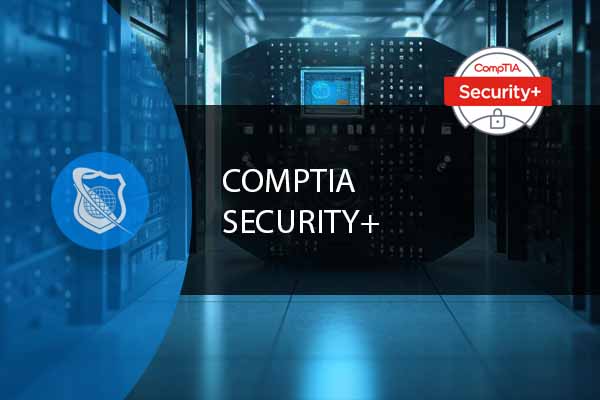The Importance of Architecture and Design in Security CompTIA
Welcome to the fourth installment of our 7-part series focused on Security CompTIA. Today, we’re honing in on a domain that often serves as the backbone of any cybersecurity initiative: “3.0 Architecture and Design.” This domain is not just another topic to check off your study list for the CompTIA Security+ exam. It’s a critical area that provides the foundational knowledge required to build a robust, scalable, and secure cybersecurity infrastructure. As you read on, you’ll quickly understand why mastering the intricacies of architecture and design is not only pivotal for your Security CompTIA certification but also indispensable for your long-term career in the ever-evolving field of cybersecurity.
| Domain | Percentage of Examination | Key Subtopics |
|---|---|---|
| 1.0 Threats, Attacks and Vulnerabilities | 21% | Malware Types, Types of Attacks, Threat Actors |
| 2.0 Technologies and Tools | 22% | Network Components, Software Tools, Troubleshooting |
| 3.0 Architecture and Design | 15% | Frameworks, Network Architecture, Systems Design |
| 4.0 Identity and Access Management | 16% | AAA, Multifactor Authentication, Account Management |
| 5.0 Risk Management | 14% | Policies, Business Impact, Risk Assessment |
| 6.0 Cryptography and PKI | 12% | Symmetric Algorithms, Asymmetric Algorithms, Hashing |
Secure Your Networks and Prevent Password Breaches
Our robust CompTIA Sec+ course is the perfect resouce to ensure your company’s most valuable assets are safe. Up your security skills with this comprehensive course at an exceptional price.
Why Architecture and Design Are Pivotal in Security CompTIA
When it comes to cybersecurity, architecture and design are more than just buzzwords; they are the blueprint that dictates the efficacy of your entire security strategy. This domain teaches you how to construct a cybersecurity framework that is not only robust but also adaptable to the ever-changing threat landscape. It covers everything from the selection of appropriate security controls to the design of network topology and the implementation of security policies. In essence, mastering architecture and design in the context of Security CompTIA equips you with the skills to lay a solid foundation for a secure and resilient cybersecurity infrastructure. This is not just a requisite for passing your Security CompTIA exam; it’s a skill set that will serve you throughout your cybersecurity career, helping you to design solutions that are both effective and adaptable to emerging threats.
Core Concepts in Security Architecture and Design
Security Models: The Theoretical Framework
In the realm of cybersecurity, theory often precedes practice, and this is where security models come into play. These models, such as the Bell-LaPadula or Biba models, serve as the theoretical frameworks that guide the development of security policies and procedures. They help you understand the principles behind data confidentiality, integrity, and availability. These models are not just academic concepts; they are practical tools that help you design robust security architectures. As such, they form a cornerstone in the Security CompTIA curriculum and are indispensable for real-world application. Mastering these models is not just about passing the Security CompTIA exam; it’s about gaining the theoretical grounding needed to tackle complex cybersecurity challenges effectively.
Security Controls: The Building Blocks
Security controls are the tangible mechanisms that bring security policies to life. Whether it’s a physical control like a biometric scanner at the entrance of a data center or a logical control like a firewall that filters incoming and outgoing traffic, these controls are the building blocks of your security architecture. Understanding how to select and implement these controls effectively is a key aspect of Security CompTIA. This domain equips you with the knowledge to discern which controls are most suitable for different scenarios, thereby enhancing your ability to build a secure and resilient cybersecurity infrastructure.
Layered Security: Defense in Depth
In the ever-evolving landscape of cybersecurity threats, relying on a single line of defense is a recipe for disaster. This is where the concept of layered security, also known as defense in depth, comes into play. It involves the strategic implementation of multiple security measures at different layers—network, application, physical, etc.—to provide a more comprehensive defense against a wide range of threats. This multi-layered approach is highly recommended in Security CompTIA best practices and is crucial for building a resilient security infrastructure. By mastering the principles of layered security, you’re not just preparing to ace your Security CompTIA exam; you’re also equipping yourself with a holistic approach to cybersecurity that will serve you well in any professional setting.
Secure Your Networks and Prevent Password Breaches
Our robust CompTIA Sec+ course is the perfect resouce to ensure your company’s most valuable assets are safe. Up your security skills with this comprehensive course at an exceptional price.
Best Practices in Security Architecture and Design
Principle of Least Privilege
The principle of least privilege is a cornerstone of effective security architecture. It advocates for limiting user and system access rights to the bare minimum necessary to complete specific tasks. By restricting access, you reduce the risk of unauthorized data manipulation or exposure. This principle is not just a theoretical concept but a practical measure that has been proven to reduce the risk of insider threats and data breaches. It is a fundamental aspect of security architecture that is emphasized in Security CompTIA training. Adhering to this principle is not just about compliance; it’s about creating a culture of security awareness and responsibility, which is a core tenet of Security CompTIA.
Secure Coding Practices
In today’s digital age, software is at the heart of most business operations, making secure coding practices more critical than ever. Writing secure code means developing software that is resilient against common vulnerabilities like SQL injection, cross-site scripting, and buffer overflows. These practices are essential for anyone involved in software development, whether you’re a developer, a security analyst, or an IT manager. Secure coding is covered extensively in the Security CompTIA exam, emphasizing its importance in the broader cybersecurity landscape. Mastering secure coding practices is not just about passing the Security CompTIA exam; it’s about contributing to the development of safer, more reliable software systems [1].
Regular Audits and Assessments
Regular security audits and assessments are the pulse checks of any cybersecurity program. They offer an objective evaluation of your security architecture, revealing strengths and exposing weaknesses. These audits are not just a box-ticking exercise but a critical component of ongoing security management. They ensure that your security measures are aligned with industry standards, such as ISO 27001 or NIST frameworks, and are capable of defending against current and emerging threats. This practice is not just a requirement for Security CompTIA certification but also a crucial aspect of corporate governance and risk management.
Real-world Applications: Beyond the Security CompTIA Exam
The value of mastering the architecture and design domain in Security CompTIA cannot be overstated. Its real-world applications are vast and varied, extending far beyond the confines of the exam room. Whether you find yourself tasked with designing a cutting-edge security infrastructure for a burgeoning startup or overhauling an existing system for a Fortune 500 company, the principles and best practices you’ve learned here will be your guiding light. From the selection and implementation of appropriate security controls to the strategic deployment of a multi-layered security strategy, the knowledge and skills you acquire are directly applicable to the myriad challenges you’ll inevitably face in your cybersecurity career. In essence, Security CompTIA serves as both a learning platform and a professional toolkit, equipping you with the practical skills needed to excel in the real world.
Secure Your Networks and Prevent Password Breaches
Our robust CompTIA Sec+ course is the perfect resouce to ensure your company’s most valuable assets are safe. Up your security skills with this comprehensive course at an exceptional price.
Conclusion: The Integral Role of Architecture and Design in Security CompTIA
As we wrap up this comprehensive exploration of the architecture and design domain, one thing is abundantly clear: these are not mere theoretical constructs designed for exam success. They are, in fact, practical skills and a body of knowledge that can significantly influence an organization’s cybersecurity posture. This blog has aimed to provide a thorough understanding of this critical domain, emphasizing its integral role in Security CompTIA. Armed with this knowledge, you’re not just better prepared to ace your Security CompTIA exam; you’re also well on your way to evolving from a cybersecurity novice to a seasoned cybersecurity professional. The principles you’ve learned and the best practices you’ve explored are your stepping stones to a fulfilling and impactful career in cybersecurity.
CompTIA Security+ Architecture and Design : Frequently Asked Questions
What are the key principles of secure network architecture in CompTIA Security+ Architecture and Design?
In the CompTIA Security+ Architecture and Design domain, secure network architecture principles include layered security (defense in depth), the principle of least privilege, secure network segmentation, and redundancy. These principles ensure that networks are not only resistant to unauthorized access but also resilient in the face of failures or attacks, facilitating continuity of operations.
How does CompTIA Security+ Architecture and Design address cloud security concerns?
CompTIA Security+ Architecture and Design emphasizes the importance of cloud service models (IaaS, PaaS, SaaS), cloud deployment models (public, private, hybrid, community), and cloud security best practices. It covers cloud access security brokers (CASBs), secure data policies, and understanding the shared responsibility model, which delineates the security responsibilities between the cloud service provider and the client.
What role does cryptography play in CompTIA Security+ Architecture and Design?
Cryptography is crucial in CompTIA Security+ Architecture and Design for ensuring data confidentiality, integrity, and authenticity. It covers symmetric and asymmetric encryption, cryptographic protocols, and the use of digital certificates and Public Key Infrastructure (PKI) to secure data in transit and at rest, as well as to verify the identity of parties involved in digital communications.
Can you explain the concept of secure system design elements covered in CompTIA Security+ Architecture and Design?
Secure system design elements in CompTIA Security+ Architecture and Design include hardware and firmware security features like Trusted Platform Module (TPM) and Unified Extensible Firmware Interface (UEFI), secure boot processes, and data execution prevention. These elements ensure that systems are resilient to tampering and unauthorized access, starting from the boot process up to the application level.
What are the best practices for disaster recovery planning in the CompTIA Security+ Architecture and Design framework?
Best practices for disaster recovery planning within the CompTIA Security+ Architecture and Design framework include conducting a business impact analysis (BIA), establishing recovery time objectives (RTO) and recovery point objectives (RPO), implementing regular backups, and testing disaster recovery plans to ensure they are effective and up-to-date. These practices help organizations prepare for and quickly recover from disasters, minimizing downtime and data loss.
Explore Our Comprehensive 6-Part Series on CompTIA Network+ Exam Domains
Dive deep into the world of networking with our extensive 6-part blog series designed to be your ultimate guide for the CompTIA A+ Exam. Each blog focuses on a specific domain, providing expert insights, study tips, and real-world applications to help you master the subject and ace the exam. Click on the titles below to explore each domain in detail.
CompTIA Security+ Certification: Your Ultimate Guide (1 of 7 Part Series)
CompTIA Security+ Objectives : Threats, Attacks and Vulnerabilities (2 of 7 Part Series)
CompTIA Security: Technologies and Tools (3 of 7 Part Series)
Security CompTIA : Architecture and Design (4 of 7 Part Series)
CompTIA Security +: Identity and Access Management (5 of 7 Part Series)
CompTIA Security Plus : Risk Management (6 of 7 Part Series)
Security CompTIA + : Cryptography and PKI (7 of 7 Part Series)

























